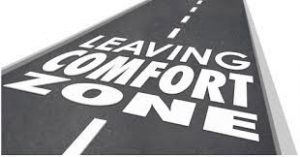As a new year kicks off, thoughtful leaders are taking a moment or two to consider how they can lead better in 2019.
It could be people skills, communication, strategy and tactics, achieving business outcomes more effectively, stakeholder partnerships – there’s always something (and if not, a review or check-in with your team will help you find a few).
But, knowing what we would ideally improve, and doing it, are two different things.
Sometimes, the culprit is the good old ‘comfort zone’. Our comfort zone keeps us safe, and, well … comfortable! But is it always the best place to hang out?
In our comfort zone, we are treading the familiar path. We are relatively free of feelings of stress and risk. We have a sense of security and relative certainty. Outside our comfort zone, we’re trying something different; taking risks. We’re acting in a less familiar way, so we’re less sure what will happen, or how we or others will react. We might be opening ourselves up to stress and anxiety.
What’s so bad about a comfort zone anyway?
So why not just stay in that safe and cozy place? Well, while it isn’t ‘bad’, and in fact it’s natural and healthy to spend time in the comfort zone, there are downsides to never stepping outside it.
One is about results. While operating within our comfort zone will bring predictable results, results are also in the realm of ‘safe’, and probably only at the level of acceptable or below.
Another is about growth. Growth is encouraged by stretching ourselves, not just doing what we’ve always done.
Ultimately if we stay within our comfort zone, improvement will be slow and incremental at best. In that sense our comfort zone holds us back.
At the other extreme, way outside our comfort zone, results and growth are also compromised through fear, stress, anxiety reactions and even total shutdown – which will also undermine performance and growth.
“If a long stretch step might be to deliver a TED talk, and your comfort zone is chatting quietly with your dog, start with a small step in the right direction”
Somewhere in between, the zone of ‘optimal anxiety’ was identified by psychologists Robert Yerkes and John Dodson back over 100 years ago. This is where we are uncomfortable to a point, but able to function in new areas and as a result generate growth.
What is your zone?
All leaders have some idea of what their own comfort zone is. But blind spots can mean that we’ve actually lost awareness of where we’re sitting inside limited constraints that no longer (or don’t always) serve us.
It’s also common to rationalise why we have certain comfortable limitations. And it’s true, things we took on or learned early in life or early in our careers might have been a necessary response to difficult circumstances at the time. Sometimes it takes deep reflection to realise that those boundaries are now only held in place by us self-imposing them (presumably no-none else but ourselves is holding them in place now, no matter how they might have started).
But wherever they came from, and not matter how much they feel like a natural part of your identity, if as a leader you’re just sitting inside that same zone again through 2019, you won’t generate results any different to what you did previously.
Leaders develop as they step outside their comfort zone
How about taking a moment to plan one thing you will do today to test out stepping outside the comfort zone. You’ll probably be pleasantly surprised at the new outcomes you create.
Imagine, if you were to ask a few advisers in confidence what you could change that would have the biggest impact on your leadership this year, what would they say? Some key areas will quickly come to mind as you tap into your intuitive insights (if not, again, consider a leadership review of some sort).
And then, what are the obvious suggestions that would have you make some significant developments in those areas?
It doesn’t have to be ‘one giant leap’
You don’t have to step waaaay outside your comfort zone all in one go.
Baby steps can help. If a long stretch step might be to deliver a TED talk, and your comfort zone is chatting quietly with your dog, a small step in the right direction could be to talk with other dog owners, arrange a group activity, and then speak to the group at that. Before you know it, you’ll be running ‘Dogs Australia!’
In a leadership context, assuming you already have some insight into gaps in your leadership style, use a similar method to target one area you want to develop in, with a baby step or two first. Then add in some further stretch steps towards the bigger goal.
This will help ensure you get the benefits of expanding those comfort zone boundaries without encountering the downsides of the ‘step too far’, but ultimately getting to that further point in a more comfortable way.
Hey, that might bring stepping outside your comfort zone, into your comfort zone!

If you want some help identifying what areas to focus on in building your leadership comfort zone, get in touch.

